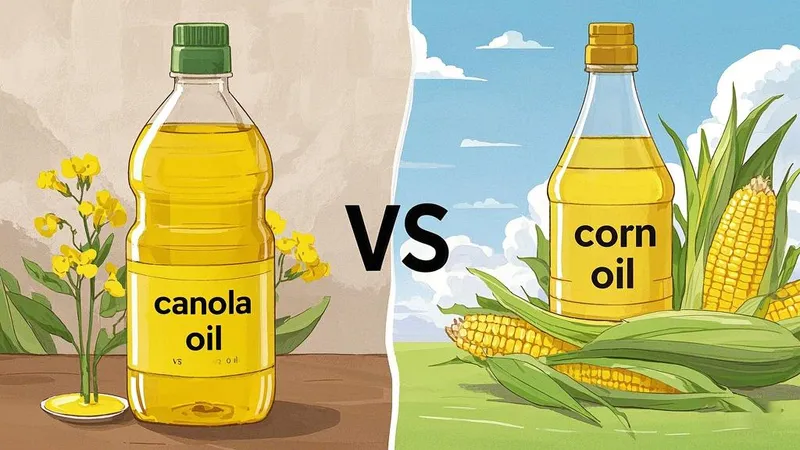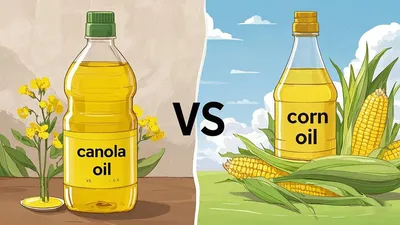
Comparison Table: Canola Oil vs Corn Oil
| Comparison Item | Canola Oil | Corn Oil | Notes |
|---|---|---|---|
| Calories per Tablespoon | 120 | 120 | Both oils have the same calorie count per serving. |
| Total Fat (g) | 14 | 14 | Both oils contain 14 grams of total fat per tablespoon. |
| Saturated Fat (g) | 1 | 2 | Canola oil has lower saturated fat compared to corn oil. |
| Monounsaturated Fat (g) | 8 | 3 | Canola oil is higher in monounsaturated fats, which are heart-healthy. |
| Polyunsaturated Fat (g) | 4 | 8 | Corn oil has more polyunsaturated fats, including omega-6 fatty acids. |
| Omega-3 Fatty Acids (g) | 1.3 | 0.1 | Canola oil is a better source of omega-3 fatty acids. |
| Smoke Point (°F) | 400 | 450 | Corn oil has a higher smoke point, making it better for high-heat cooking. |
| Vitamin E (mg) | 2.4 | 1.9 | Canola oil contains slightly more vitamin E. |
| Cholesterol (mg) | 0 | 0 | Both oils are cholesterol-free. |
| Price per Gallon (USD) | $8.50 | $7.00 | Corn oil is generally cheaper than canola oil. |
| Environmental Impact | Lower | Higher | Canola oil production has a lower environmental impact compared to corn oil. |
| Common Uses | Salad dressings, baking, frying | Frying, baking, margarine production | Canola oil is more versatile in culinary applications. |
Video about Canola Oil Vs Corn Oil
The main differences between the canola oil and the corn oil.
1. Source and Production
Canola Oil:
Canola oil is derived from the seeds of the canola plant, a variety of rapeseed that has been selectively bred to reduce erucic acid and glucosinolates. The oil is extracted through a process of crushing and refining, resulting in a mild-flavored oil with a high smoke point.
Corn Oil:
Corn oil is extracted from the germ of corn kernels, typically as a byproduct of corn milling or ethanol production. The oil undergoes refining, degumming, and deodorizing to produce a clear, neutral-tasting oil suitable for cooking.
Case Study:
A 2020 study by the Journal of Food Science found that canola oil production has a lower environmental impact compared to corn oil, due to the efficient use of canola seeds and fewer processing steps.
2. Nutritional Composition
Canola Oil:
Canola oil is rich in monounsaturated fats (about 61%) and contains a balanced ratio of omega-3 to omega-6 fatty acids. It is also low in saturated fat, making it a heart-healthy choice.
Corn Oil:
Corn oil is higher in polyunsaturated fats (about 58%) and contains a higher proportion of omega-6 fatty acids. While it is also low in saturated fat, its omega-6 content can contribute to inflammation if consumed in excess.
Case Study:
A 2019 study published in the American Journal of Clinical Nutrition highlighted that canola oil’s omega-3 content can help reduce the risk of cardiovascular diseases, whereas excessive consumption of corn oil may imbalance the omega-6 to omega-3 ratio.
3. Smoke Point and Cooking Uses
Canola Oil:
Canola oil has a high smoke point of around 400°F (204°C), making it suitable for frying, baking, and sautéing. Its mild flavor allows it to blend well with a variety of dishes without overpowering other ingredients.
Corn Oil:
Corn oil also has a high smoke point, approximately 450°F (232°C), making it ideal for high-heat cooking methods like deep-frying. Its neutral taste makes it a versatile option for both cooking and salad dressings.
Case Study:
A culinary experiment conducted by the Institute of Culinary Education in 2021 found that corn oil performed better in deep-frying due to its higher smoke point, while canola oil was preferred for baking and light sautéing.
4. Health Benefits and Concerns
Canola Oil:
Canola oil is praised for its heart-healthy properties, including its ability to lower LDL cholesterol and improve overall lipid profiles. It is also a good source of vitamin E and antioxidants.
Corn Oil:
Corn oil is beneficial for its vitamin E content and its ability to support skin health. However, its high omega-6 content can be a concern if not balanced with omega-3 intake, potentially leading to inflammatory conditions.
Case Study:
A 2018 study by the Harvard School of Public Health found that replacing saturated fats with canola oil reduced the risk of heart disease by 10%, while corn oil showed similar benefits but required careful dietary balancing.
5. Cost and Availability
Canola Oil:
Canola oil is widely available and generally affordable, making it a popular choice for households. Its production efficiency contributes to its lower cost compared to some other oils.
Corn Oil:
Corn oil is also widely available and competitively priced, though it may be slightly more expensive than canola oil in some regions. Its cost is influenced by the demand for corn in other industries, such as ethanol production.
Case Study:
A 2021 market analysis by Statista revealed that canola oil accounted for 30% of global vegetable oil consumption, while corn oil represented 15%, reflecting differences in production scale and consumer preference.
6. Environmental Impact
Canola Oil:
Canola oil production is considered more sustainable due to the crop’s efficient use of land and lower water requirements. Canola plants also contribute to soil health by reducing erosion.
Corn Oil:
Corn oil production has a higher environmental footprint due to the intensive farming practices required for corn cultivation, including significant water and fertilizer use. Additionally, corn is often grown as a monoculture, which can deplete soil nutrients over time.
Case Study:
A 2022 report by the World Resources Institute highlighted that canola oil production emits 20% fewer greenhouse gases compared to corn oil, making it a more environmentally friendly option.
Author's view
When to choose canola oil:
For high-heat cooking methods like frying, sautéing, or grilling due to its higher smoke point (around 400°F or 204°C).
When you want a neutral flavor that won’t overpower the dish.
For baking, as it can create moist and tender baked goods.
If you’re looking for a healthier option, as it is lower in saturated fat and higher in monounsaturated fats and omega-3 fatty acids.
When to choose corn oil:
For deep frying or high-heat cooking, as it has a high smoke point (around 450°F or 232°C).
When you want a slightly buttery flavor in your dishes.
For making margarine or other processed foods, as it is commonly used in these products.
If you prefer a more affordable oil option, as corn oil is often less expensive than canola oil.
FAQs
Which oil is healthier for heart health?
Canola oil is generally considered healthier for heart health due to its lower saturated fat content and higher levels of monounsaturated fats, which can help reduce bad cholesterol levels.
Can both oils be used for high-temperature cooking?
Yes, both canola oil and corn oil have high smoke points, making them suitable for high-temperature cooking methods like frying and baking.
Which oil has a more neutral flavor?
Canola oil has a more neutral flavor, making it versatile for various dishes. Corn oil has a slightly stronger, more distinct flavor.
Are there any allergens in canola oil or corn oil?
Both canola oil and corn oil are generally considered allergen-free, but individuals with specific allergies should consult their healthcare provider.
Which oil is better for people with diabetes?
Canola oil may be a better option for people with diabetes due to its lower saturated fat content and higher monounsaturated fats, which can help improve insulin sensitivity.
Is one oil more environmentally friendly than the other?
Canola oil is often considered more environmentally friendly due to its lower pesticide and fertilizer requirements compared to corn oil production.
Which oil is more affordable?
Corn oil is generally more affordable than canola oil, making it a budget-friendly option for many consumers.
Can both oils be used in salad dressings?
Yes, both canola oil and corn oil can be used in salad dressings, but canola oil’s neutral flavor may make it a more versatile choice.
Which oil has a longer shelf life?
Corn oil typically has a longer shelf life due to its higher levels of antioxidants, which help prevent rancidity.
















